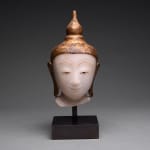Shan Marble Buddha Head, 1700 CE - 1800 CE
24.8 x 14 cm
9 3/4 x 5 1/2 in
9 3/4 x 5 1/2 in
TAHER.006
Further images
The Shan people are a distinct ethnic group that today constitute Myanmar’s largest minority group. However, from the 13th until the 16th Century, they dominated most of the country. They...
The Shan people are a distinct ethnic group that today constitute Myanmar’s largest minority group. However, from the 13th until the 16th Century, they dominated most of the country. They are largely Buddhist, and their language and customs are closely related to the Thai and Laotians, their neighbors to the south and east. In the 19th Century, long after their power had eroded, they were distributed among thirty petty states that paid tribute first to the Burman King, then to the British. This arrangement remained more or less in tact until 1922 when the Federated Shan States were joined together. In 1947, a unified Shan States was created under the Burmese Constitution. Although much of their autonomy has been relinquished to the central government, the Shan retain their unique cultural identity and ethnic heritage.
The historical figure, Buddha Gautama Sakyamuni is the Buddha of compassion who, having achieved the highest evolutionary perfection, turns suffering into happiness for all living beings. Born around 560 B.C. somewhere between the hills of south Nepal and the Rapti river, his father was a Raja who ruled over the northeastern province of India, the district including the holy Ganges River. The young prince was married to Yashoda when he was about 17 years old and together they had a son named Rahula. At the age of 29, he left his life of luxury, as he felt compelled to purify his body and make it an instrument of the mind by ridding himself of earthly impulses and temptations.
The historical figure, Buddha Gautama Sakyamuni is the Buddha of compassion who, having achieved the highest evolutionary perfection, turns suffering into happiness for all living beings. Born around 560 B.C. somewhere between the hills of south Nepal and the Rapti river, his father was a Raja who ruled over the northeastern province of India, the district including the holy Ganges River. The young prince was married to Yashoda when he was about 17 years old and together they had a son named Rahula. At the age of 29, he left his life of luxury, as he felt compelled to purify his body and make it an instrument of the mind by ridding himself of earthly impulses and temptations.







